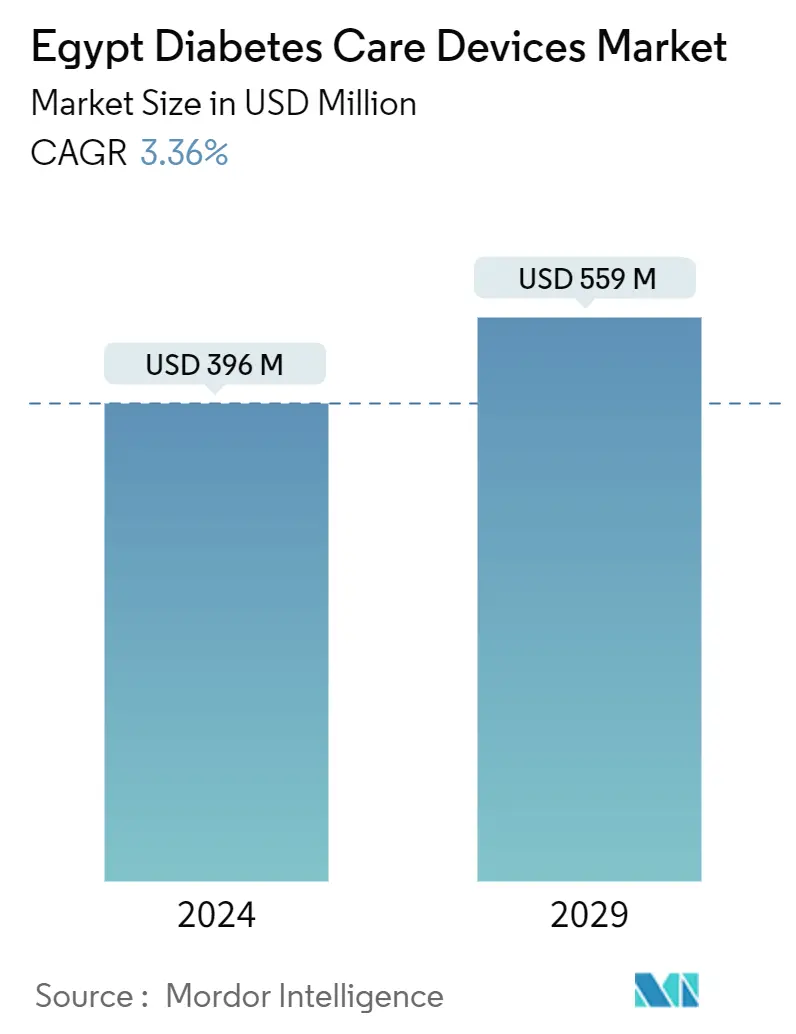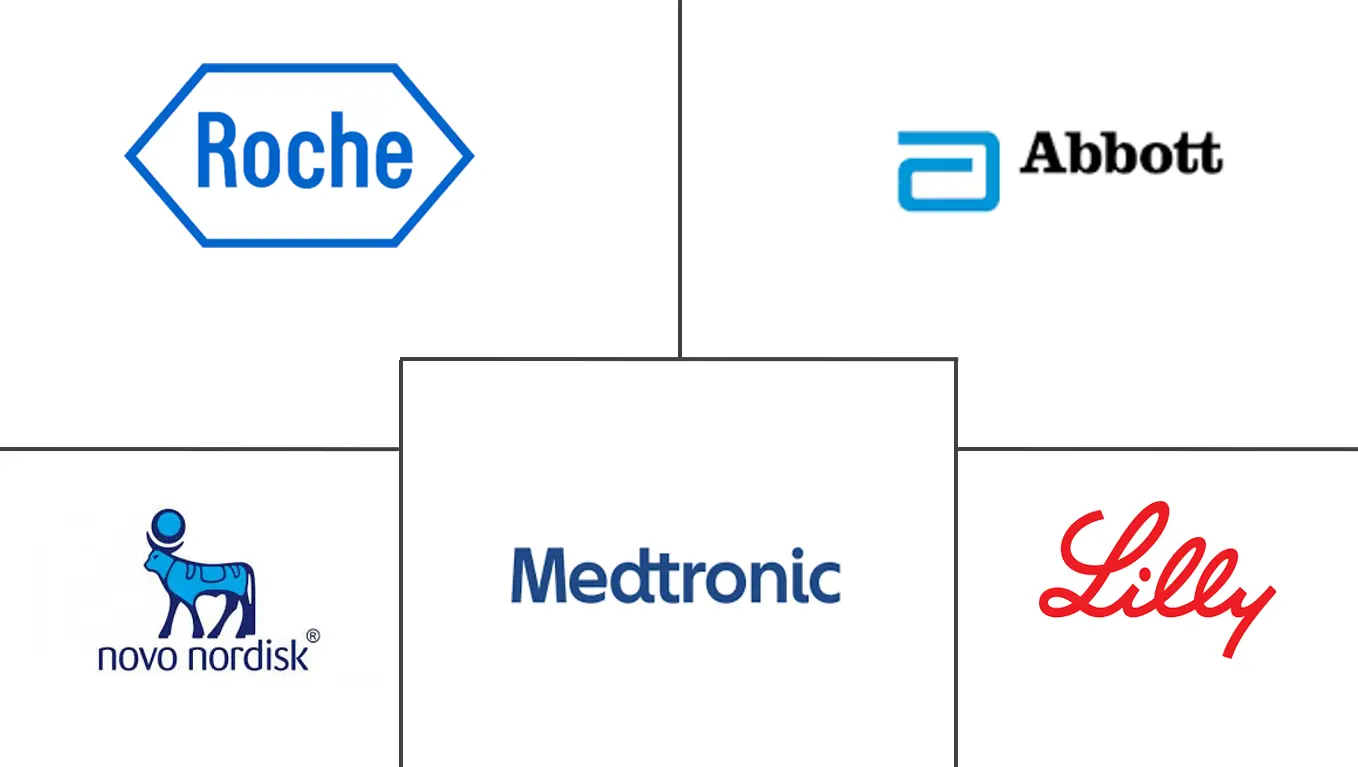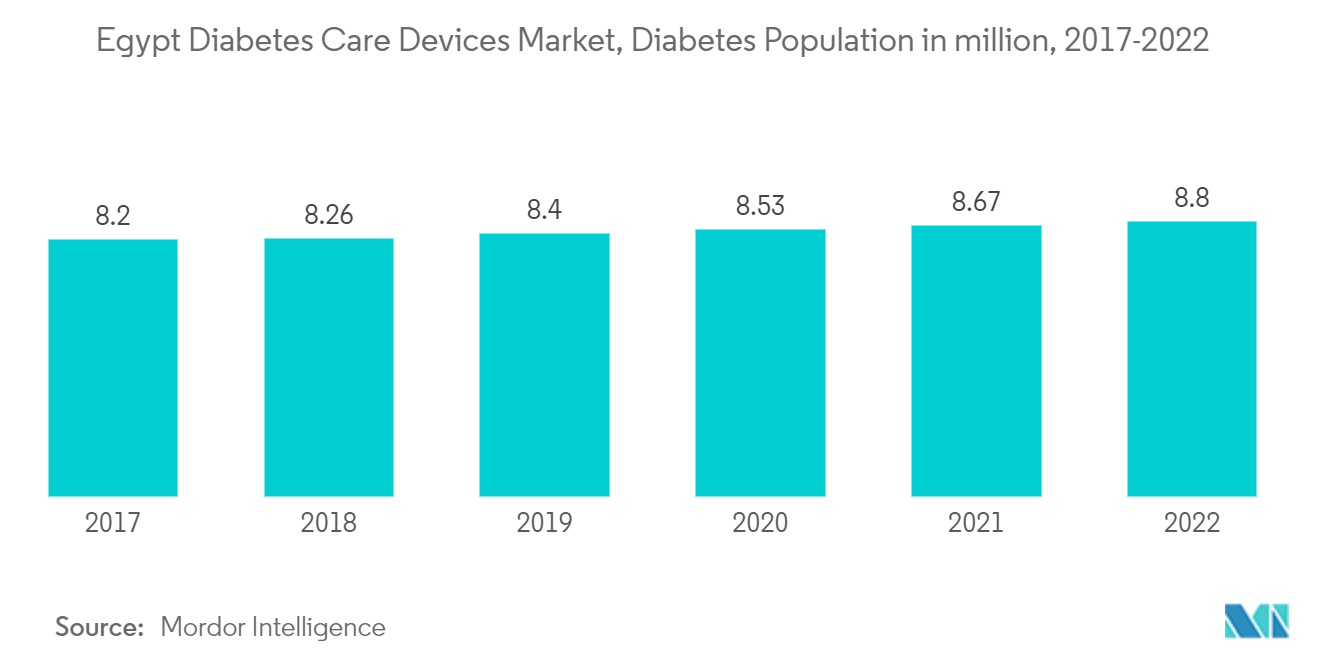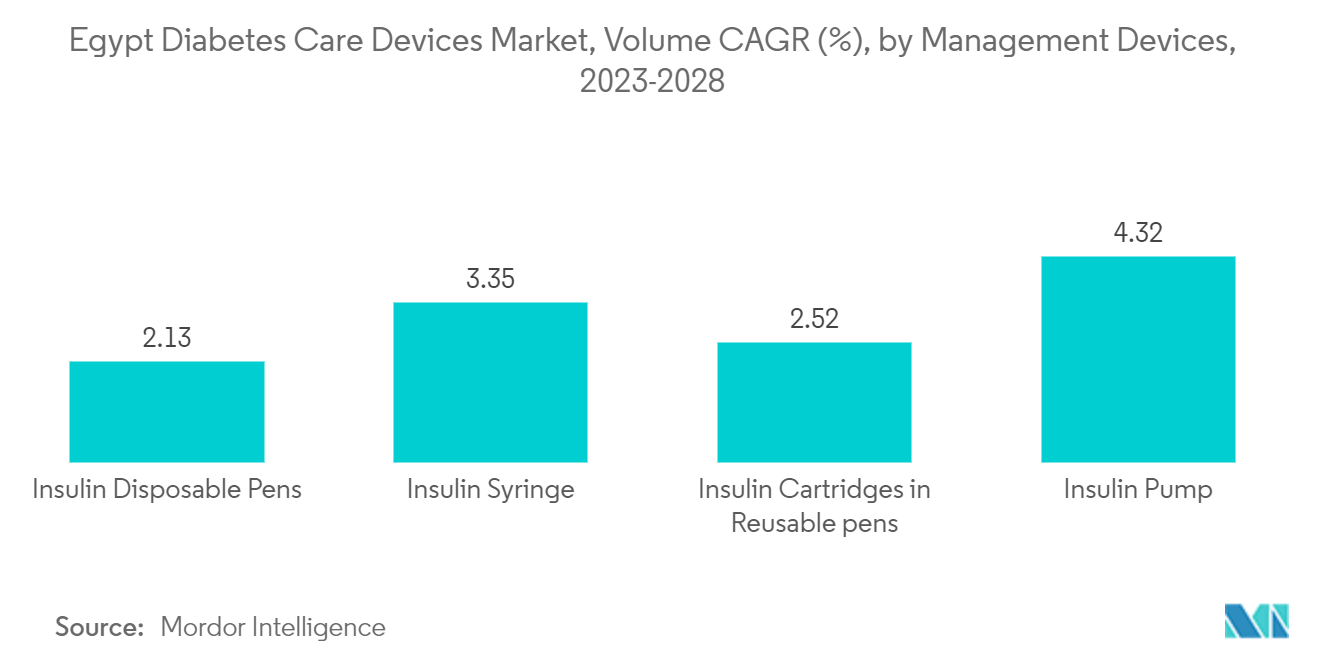Egypt Diabetes Care Devices Market Size

| Study Period | 2019- 2029 |
| Base Year For Estimation | 2023 |
| Forecast Data Period | 2024 - 2029 |
| Market Size (2024) | USD 396 Million |
| Market Size (2029) | USD 559 Million |
| CAGR (2024 - 2029) | 3.36 % |
Major Players
*Disclaimer: Major Players sorted in no particular order |
Egypt Diabetes Care Devices Market Analysis
The Egypt Diabetes Care Devices Market size is estimated at USD 396 million in 2024, and is expected to reach USD 559 million by 2029, growing at a CAGR of 3.36% during the forecast period (2024-2029).
The COVID-19 pandemic positively impacted Egypt's diabetes care devices market growth. Patients with diabetes infected with COVID-19 were believed to experience elevated blood glucose, abnormal glucose variability, and diabetic complications. The prevalence of diabetes in people with COVID-19 caused a significant increase in the severity and mortality of COVID-19 in people with either type-1 (T1DM) or type-2 diabetes mellitus (T2DM), especially associated with poor glycemic control. While new-onset hyperglycemia and new-onset diabetes (both T1DM and T2DM) have been increasingly recognized in COVID-19 and associated with worse outcomes. To avoid aggravation, a patient's blood glucose should be monitored and managed regularly, which has underlined the importance of diabetes care devices. The pandemic emergency has created a rise in remote care.
Egypt is the ninth country in terms of Diabetes prevalence worldwide. Currently, as per IDF, about 18.4% of the adult population in Egypt has diabetes. More than 11% of the Egyptian population suffers from diagnosed Type-2 diabetes, according to the Egypt Youth Association for Health Development. 73 million adults (20-79) were likely to live with diabetes in the IDF MENA Region 2021. This figure is estimated to increase to 95 million by 2030.
Egypt has witnessed an alarming increase in the prevalence of diabetes; in recent years, the rate of diabetes is at an all-time high, mainly due to lifestyle changes. Diabetes is associated with many health complications. Patients with diabetes require many daily corrections to maintain nominal blood glucose levels, such as administering additional insulin or ingesting additional carbohydrates by monitoring their blood glucose levels. Diabetes poses an emerging healthcare burden across the country.
Owing to the factors above, the studied market is anticipated to grow over the analysis period.
Egypt Diabetes Care Devices Market Trends
Continuous glucose monitoring segment is expected to witness highest growth rate over the forecast period
The continuous Glucose Monitoring Segment is expected to witness a CAGR of 12% over the forecast period.
A CGM is used by inserting a small sensor into the abdomen or arm with a tiny plastic tube known as a cannula penetrating the top layer of skin. An adhesive patch holds the sensor in place, allowing it to take glucose readings in interstitial fluid throughout the day and night. Generally, the sensors must be replaced every 7 to 14 days. A small, reusable transmitter connected to the sensor allows the system to send real-time readings wirelessly to a monitor device that displays blood glucose data. Some systems have a dedicated monitor, and some display the information via a smartphone app.
Continuous glucose monitoring sensors use glucose oxidase to detect blood sugar levels. Glucose oxidase converts glucose to hydrogen peroxidase, which reacts with the platinum inside the sensor, producing an electrical signal to be communicated to the transmitter. Sensors are the most important part of continuous glucose monitoring devices. Technological advancements to improve the accuracy of the sensors are expected to drive segment growth during the forecast period.
The frequency of monitoring glucose levels depends on the type of diabetes, which varies from patient to patient. Type-1 diabetic patients must check their blood glucose levels regularly, monitor their blood glucose levels, and adjust the insulin dosing accordingly. The current CGM devices show a detailed representation of blood glucose patterns and tendencies compared to a routine check of glucose levels at set intervals. Furthermore, the current continuous glucose monitoring devices can either retrospectively display the trends in blood glucose levels by downloading the data or give a real-time picture of glucose levels through receiver displays. Such advantages helped the rise in the adoption of these products in the market.
The major risk observed among the Egyptian population is unhealthy diet, sedentary lifestyle habits, and a family history of diabetes. The Egypt blood glucose monitoring market grew to monitor glycosylated hemoglobin levels. Most diabetic patients in Egypt use blood glucose monitoring devices to control blood glucose levels and their fluctuations. Thus, because of the high diabetes prevalence and technological adaptation, the market is growing in Egypt.

Insulin disposable pens hold the highest share in the management devices segment in the current year
Insulin Disposable pens hold the highest share of about 37% in the management devices segment in the current year.
A disposable insulin pen contains a prefilled amount of insulin. When the pen is empty, it is thrown away. Insulin pens are much smaller and more portable than syringes, containing the medicine preloaded into the delivery mechanism. The needles are easy to use and can be disposed of by twisting or snapping. The pens are usually color-coded, making it easier to know which type of insulin and how much it will be received from them. The disposable insulin pens are considered more consumer-friendly, as they are smaller and less noticeable than the classic vial-and-syringe. These devices are also more portable for consumers on the go. Some pens are smart insulin pens that easily connect to an app on the phone to monitor blood sugar levels and remind when to take the next insulin dose.
In Egypt, the social level plays an important role in patients' access to health care since the number of healthcare centers, hospitals, and pharmacies is very low in rural areas compared to big cities and urban areas. The financial level is a major determinant of people's access to health care, as the salaries of most of the employees in Egypt are not enough to afford their monthly diabetes supplies. For students and school children with type 1 diabetes, the National Health Insurance System covers insulin, and the student pays nothing for NPH, mixed and short-acting insulins, and only 60% of the price of other types of insulin, which are usually unavailable in the pharmacies of the National Health Insurance System. However, the government is working in the direction of improving the access of patients through various initiatives.
The Egyptian Government Launched the '100 million Seha' initiative, which seeks to screen Egyptians for non-communicable diseases like diabetes. Various healthcare companies announced their collaboration with the Egypt Ministry of Health to promote the initiative. Such initiatives are expected to create awareness among the people regarding monitoring and controlling diabetes, thereby enhancing the market prospects in the coming years.

Egypt Diabetes Care Devices Industry Overview
The Egypt Diabetes Care Devices Market is semi-consolidated, with few significant and generic players. Manufacturers drove constant innovations to compete in the market. The major players, such as Abbott and Medtronic, underwent many mergers, acquisitions, and partnerships to establish market dominance while adhering to organic growth strategies. It is evident from the R&D spending of these companies.
Egypt Diabetes Care Devices Market Leaders
-
Abbott Diabetes Care
-
Medtronic PLC
-
Roche Diabetes Care
-
Eli Lilly and Company
-
Novo Nordisk A/S
*Disclaimer: Major Players sorted in no particular order

Egypt Diabetes Care Devices Market News
- October 2022: Becton, Dickinson, and Company and Biocorp signed an agreement to use connected technology to track adherence to self-administered drug therapies, like biologics. To support biopharmaceutical companies in their efforts to improve the adherence and outcomes of injectable drugs, the two companies were to integrate Biocorp's Injay technology. It was a solution designed to capture and transmit injection events using Near Field Communication technology to the BD UltraSafe Plus Passive Needle Guard used with pre-fillable syringes.
- June 2022: Abbott announced that it was developing a new bio-wearable that would continuously monitor glucose and ketone levels in one sensor. The glucose-ketone sensor will be the same size as Abbott's FreeStyle Libre 3 sensor, the world's smallest and thinnest continuous glucose monitoring sensor. It was to connect to Abbott's digital ecosystem, including personal and caregiver mobile apps and cloud-based data management software for remote monitoring by healthcare professionals.
Egypt Diabetes Care Devices Market Report - Table of Contents
1. INTRODUCTION
- 1.1 Study Assumptions and Market Definition
- 1.2 Scope of the Study
2. RESEARCH METHODOLOGY
3. EXECUTIVE SUMMARY
4. MARKET DYNAMICS
- 4.1 Market Overview
- 4.2 Market Drivers
- 4.3 Market Restraints
-
4.4 Porter's Five Forces Analysis
- 4.4.1 Bargaining Power of Suppliers
- 4.4.2 Bargaining Power of Consumers
- 4.4.3 Threat of New Entrants
- 4.4.4 Threat of Substitute Products and Services
- 4.4.5 Intensity of Competitive Rivalry
5. MARKET SEGMENTATION
-
5.1 Monitoring Devices
- 5.1.1 Self-monitoring Blood Glucose Devices
- 5.1.1.1 Glucometer Devices
- 5.1.1.2 Blood Glucose Test Strips
- 5.1.1.3 Lancets
- 5.1.2 Continuous Glucose Monitoring Devices
- 5.1.2.1 Sensors
- 5.1.2.2 Durables (Receivers and Transmitters)
-
5.2 Management Devices
- 5.2.1 Insulin Pump
- 5.2.1.1 Insulin Pump Device
- 5.2.1.2 Insulin Pump Reservoir
- 5.2.1.3 Infusion Set
- 5.2.2 Insulin Syringes
- 5.2.3 Cartridges in Reusable pens
- 5.2.4 Insulin Disposable Pens
- 5.2.5 Jet Injectors
-
5.3 Distribution Channel
- 5.3.1 Online
- 5.3.2 Offline
6. MARKET INDICATORS
- 6.1 Type-1 Diabetes Population
- 6.2 Type-2 Diabetes Population
7. COMPETITIVE LANDSCAPE
-
7.1 COMPANY PROFILES
- 7.1.1 Dexcom Inc.
- 7.1.2 Insulet Corporation
- 7.1.3 Medtronic PLC
- 7.1.4 Roche Diabetes Care
- 7.1.5 Novo Nordisk A/S
- 7.1.6 Ascensia Diabetes Care
- 7.1.7 Agamatrix Inc.
- 7.1.8 Bionime Corporation
- 7.1.9 Lifescan Inc.
- 7.1.10 Abbott Diabetes Care
- 7.1.11 Eli Lilly
- 7.1.12 Sanofi
- 7.1.13 Rossmax
- *List Not Exhaustive
-
7.2 COMPANY SHARE ANALYSIS
- 7.2.1 Self-monitoring Blood Glucose Devices
- 7.2.1.1 Abbott Diabetes Care
- 7.2.1.2 LifeScan
- 7.2.1.3 Others
- 7.2.2 Continuous Glucose Monitoring Devices
- 7.2.2.1 Abbott Diabetes Care
- 7.2.2.2 Medtronic PLC
- 7.2.2.3 Other Continuous Glucose Monitoring Devices
- 7.2.3 Insulin Devices
- 7.2.3.1 Insulet Corporation
- 7.2.3.2 Novo Nordisk A/S
- 7.2.3.3 Other Insulin Devices
8. MARKET OPPORTUNITIES AND FUTURE TRENDS
** Subject To AvailablityEgypt Diabetes Care Devices Industry Segmentation
Diabetes care devices are the hardware, equipment, and software used by diabetes patients to regulate blood glucose levels, prevent diabetes complications, lessen the burden of diabetes, and enhance the quality of life. The Egypt Diabetes Care Devices Market is segmented into monitoring devices (self-monitoring blood glucose devices (glucometer devices, blood glucose test strips, and lancets), continuous glucose monitoring devices (sensors and durables (receivers and transmitters)), management devices (insulin pumps (insulin pump device, insulin pump reservoir, and infusion set), insulin syringes, cartridges in reusable pens, disposable pens, and jet injectors). The report offers the value (USD) and volume (units) for the above segments.
| Monitoring Devices | Self-monitoring Blood Glucose Devices | Glucometer Devices |
| Blood Glucose Test Strips | ||
| Lancets | ||
| Monitoring Devices | Continuous Glucose Monitoring Devices | Sensors |
| Durables (Receivers and Transmitters) | ||
| Management Devices | Insulin Pump | Insulin Pump Device |
| Insulin Pump Reservoir | ||
| Infusion Set | ||
| Management Devices | Insulin Syringes | |
| Cartridges in Reusable pens | ||
| Insulin Disposable Pens | ||
| Jet Injectors | ||
| Distribution Channel | Online | |
| Offline |
Egypt Diabetes Care Devices Market Research FAQs
How big is the Egypt Diabetes Care Devices Market?
The Egypt Diabetes Care Devices Market size is expected to reach USD 396 million in 2024 and grow at a CAGR of 3.36% to reach USD 559 million by 2029.
What is the current Egypt Diabetes Care Devices Market size?
In 2024, the Egypt Diabetes Care Devices Market size is expected to reach USD 396 million.
Who are the key players in Egypt Diabetes Care Devices Market?
Abbott Diabetes Care, Medtronic PLC, Roche Diabetes Care, Eli Lilly and Company and Novo Nordisk A/S are the major companies operating in the Egypt Diabetes Care Devices Market.
What years does this Egypt Diabetes Care Devices Market cover, and what was the market size in 2023?
In 2023, the Egypt Diabetes Care Devices Market size was estimated at USD 382.69 million. The report covers the Egypt Diabetes Care Devices Market historical market size for years: 2019, 2020, 2021, 2022 and 2023. The report also forecasts the Egypt Diabetes Care Devices Market size for years: 2024, 2025, 2026, 2027, 2028 and 2029.
Egypt Diabetes Care Devices Industry Report
Statistics for the 2024 Egypt Diabetes Care Devices market share, size and revenue growth rate, created by Mordor Intelligence™ Industry Reports. Egypt Diabetes Care Devices analysis includes a market forecast outlook to 2029 and historical overview. Get a sample of this industry analysis as a free report PDF download.



